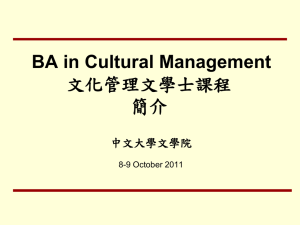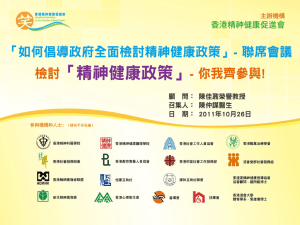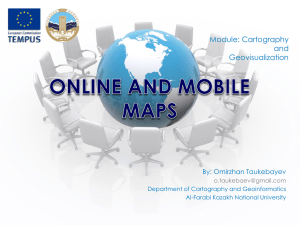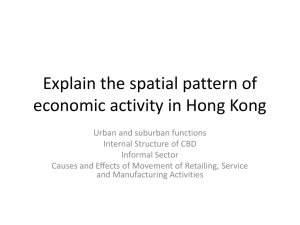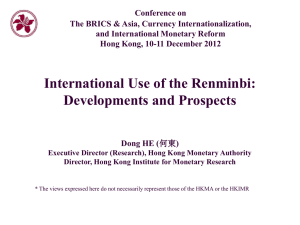Valuation Models for MNCs and Global Investors
advertisement
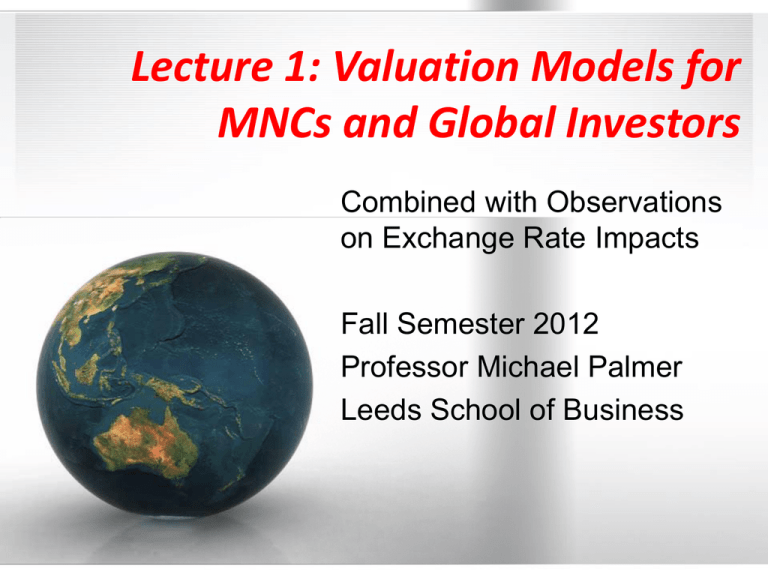
Lecture 1: Valuation Models for MNCs and Global Investors Combined with Observations on Exchange Rate Impacts Fall Semester 2012 Professor Michael Palmer Leeds School of Business Where is this International Financial Center? Defining A Financial Center A Financial Center is a location: That has a heavy concentration of financial institutions providing a wide range of financial services (including banking, insurance, cash management, asset management). London, New York, and Tokyo are regarded as the world's three premier financial centers. An Offshore Financial Center is a location: That provides financial services to nonresidents on a scale that is disproportionately larger in comparison to the size and the financing of its domestic economy (IMF definition). Examples include: The Cayman Islands, Gibraltar, Bahrain, and Hong Kong The Cayman Islands, with a domestic population of 52,000, has 250 banks, with approximately $415 billion in deposits (making it one of the largest financial centers in the world). Is London an offshore financial center? Objective of Lecture 1 In order to understand and appreciate the international forces which multinational firms and global investors face, we need to develop valuation models for global companies and investors. The models which we will develop are patterned after the Anglo-Saxon model of corporate behavior and investment valuations. Valuation Concepts Anglo-Saxon Approach: Firm Evaluation: Consider the value of the firm and corporate behavior in terms of (maximizing) the market value of the firm for shareholders. Capital budgeting techniques evaluate projects and corporate investments on the basis of the present value of their cash flows. Financial Asset Evaluation: Consider the present value of the anticipated future income stream from a particular financial asset. Anglo-Saxon Valuation Model for Corporation: Present Value of Future Cash Flow E CF$,t V t t 1 1 k n Where E(CF$,t) represents expected cash flows to be received at the end of period t, N represents the number of periods into the future in which cash flows are received, and K represents the required rate of return by investors. Note: Changes in V occur because of changes in E(CF$,t) and/or changes in K 6 Measuring the International Cash Flows for a U.S. Based MNC E C F$ ,t E C F E S m j 1 j ,t j ,t Where CFj,t represents the amount of cash flow denominated in a particular foreign currency j at the end of period t, Where Sj,t represents the exchange rate at which the foreign currency can be converted into U.S. dollars at the end of period t. Measured in U.S. dollars per unit of the foreign currency. 7 Changes in the Value of a MNC V changes result from: MNC Valuation Model E CF j ,t xE ( S j , t ) V t 1 k t 1 n (1) Changes in foreign market conditions: Will impact on foreign currency earnings and thus on foreign currency cash flows (CF). (2) Changes in political environment and political risk (policy of foreign government towards MNC): Will impact on foreign currency earnings and thus on foreign currency cash flows (CF). (3) Changes in the MNC’s cost of capital, i.e., the required return (k). (4) Changes in the exchange rate resulting from exposure to exchange rate risk (S); noting that: – Stronger foreign currency will increase U.S. dollar equivalent of cash flows. – Weaker foreign currency will decrease U.S. dollar equivalent of cash flows. MNCs Concentration on Foreign Markets (CF in Valuation Model) S&P 500 Companies Percent of Total Sales from Overseas Markets 2005: 43.3% 2006: 43.6% 2007: 45.8% 2008: 47.0% 2009: 46.6% 2010: 46.3% 2011: 46.1% S&P 500 Companies Geographic Breakdown 2011 2010 2009 Europe 24.0% 29.1% 25.5% Asia 15.5% 13.1% 17.7% N. Amer 9.5% 4.6% 7.8% Africa 8.0% 6.5% 7.9% S. Amer 5.7% 4.3% 5.4% U.S. MNCs Involvement in Foreign Markets (CF in Valuation Model) Company % Sales from Overseas Markets Other Comments (Major markets, etc) Intel 85% Chips and Processors to Taiwan and China McDonalds 66% Europe and Asia (400 stores in China) GE 54% Europe and China Ford 51% Canada, Europe, and China Nike 50% 1/3 of shoe manufacturing in China Amazon 45% Canada and Japan Wal-Mart 26% 5,000 stores in 14 foreign countries Starbucks 25% Canada, UK and China account for 66% Foreign MNCs Involvement in Foreign Markets (CF in Valuation Model) Company % Sales from Overseas Markets Other Comments (Major markets, etc) Komatsu 81% China accounts for 23% Canon 80.5% Europe accounts for 31.3% Bridgestone 74% North America accounts for 42% Honda 66% North America accounts for 37% 88% United States accounts for 32% 81% United States and China each account for 17% Japanese: U.K.: Rolls Royce Germany: BMW Chinese: Haier 30% Foreign Exchange Exposures for Selected MNCs Company Selected F.X. Exposure McDonalds (USA) Revenues exposed to pounds, euros, yen and yuan (renminbi) Ford (USA) Revenues exposed to Canadian dollars, pounds, euros and yuan (renminbi) Nike (USA) Costs exposed to yuan (renminbi) Komatsu (Japan) Revenues exposed to yuan (renminbi) Canon (Japan) Revenues exposed to euros and pounds Bridgestone (Japan) Revenues exposed to U.S. dollars Honda (Japan) Revenues exposed to U.S. dollars; costs exposed to U.S. dollars Rolls Royce (U.K.) Revenues exposed to U.S. dollars BMW (Germany) Revenues exposed to U.S. dollars and yuan (renminbi); costs exposed to U.S. dollars Exchange Rates Volatility (S in the Valuation Formula) Euro Exchange Rate; Daily Data: 1999 - Present Yen Exchange Rate; Daily Data: 1971 - Present Example: Exchange Rate Impacts on Operating Profits Japanese Multinationals Sony, which generates more than 70 percent of revenue outside of Japan, says it loses about 2 billion yen of annual operating profit for each yen gain against the U.S. currency. Toyota notes that every one-yen gain in the Japanese currency against the dollar reduces Toyota’s annual operating profit by 30 billion yen. Yen in 2011 Valuation Models for Financial Assets Bonds: Present value of: Coupon payments + Par Value (face or maturity value) Stocks: Present value of: In U.S., par value = $1,000 Discount rate (k) is adjusted for opportunity cost and risk adjustments. Future cash flow (Dividends, earnings) Foreign currency denominated financial assets: Valuation model adjustment needs to be made for changes in exchange rates. Do Bond Yields Vary Globally? FT Data (August 24, 2012) Do Equity Returns Vary Globally? Country and Stock Market % Change in Local Currency Terms; Dec 31, 2011 to Aug 22, 2012 Country and Stock Market % Change in Local Currency Terms; Dec 31, 2011 to Aug 22, 2012 USA: DJIA +7.8% Greece: Athex -6.0% Japan: TOPIX +4.7% Spain: Madrid SE -13.5% U.K. FTSE100 +3.6% Argentina: MERV -1.1% Canada: TSX +1.4% China: SSEA -4.2% France; CAC40 +9.6% Israel: TA-100 -0.1 Germany: DAX +19.0% MSCI Data: Singapore: STI +15.2% Developed Mkts +8.9% S. Africa: JSE +11.4 Emerging Mkts +5.8% Do Exchange Rates Affect Equity Returns? Data for 2010 Country Local Currency Return U.S. Dollar Return Japan - 1.6% +10.0% Australia - 1.3% +10.0% Switzerland - 0.4% + 6.6% Canada - 0.4% +20.1% Italy -11.6% -19.0% Germany +16.5% + 6.7% United Kingdom +11.7% + 6.9% South Africa +15.7% +26.6% Hong Kong + 8.6% + 8.4% United States (DJIA) +12.4% +12.4% Euro-Zone (17) - 0.9% - 9.2% Memo: Exchange Rates in 2010 JPY (Equity Market: -LC1.6%; +USD10.0%) GBP (Equity Market: +LC11.7%; +USD6.9%) Exchange Rates in 2010 EUR (Equity Market: -LC0.9%; -USD9.2%) HKD (Equity Market: +LC8.6%; +USD8.4%) Equity Returns, Dec 31, 2011 – Aug 22, 2012 Country Local Currency Return U.S. Dollar Return Japan + 8.0% + 5.4% Australia + 7.1% +10.1% Switzerland + 9.1% + 4.3% Canada + 1.4% + 4.3% Greece - 6.0% - 11.1% Germany +19.0% +12.6% United Kingdom + 3.6% + 4.7% Hong Kong + 7.9% + 8.0% Saudi Arabia + 9.7% + 9.7% United States (DJIA) + 7.8% + 7.8% Euro-Zone (17) + 7.3% + 1.5% Memo: And What About the BRICS? 2011 2012 to August 22 Country Local Currency Return USD Return Country Local Currency Return USD Return Brazil -14.3% -22.1% Brazil + 4.6% - 3.5% Russia -15.4% -19.0% Russia + 2.9% + 3.5% India -22.6% -34.6% India +15.5% +10.0% China -22.7% -19.1% China - 4.2% - 5.2% S. Africa + 2.4% -17.0% S. Africa +11.4% + 9.3% U.S. + 7.3% + 7.3% U.S. + 7.8% + 7.8% Do Exchange Rates Affect Bond Returns? Exchange Rate Adjusted Bond Exchange Rate Adjusted Returns Returns on Government Return on German Bonds, 1994 - 1999 Year Local Market % Change USD Return Return* in Local Currency** 1994 -1.8% 11.8% 10.0% 1995 16.3% 9.6% 25.9% 1996 7.3% -7.7% -0.4% 1997 6.2% -15.2% -9.0% 1998 10.9% 8.9% 19.8% 1999 -2.1% -14.3% -16.4% * = Interest (coupon payment) +/- Change in market price **1994 - 1998: % change in Deutschmark; 1999 % change in Euro Bonds, 2005 Hong Kong as a Financial Center After being ceded by China to the British (as a result of the Opium Wars) under the Treaty of Nanking in 1842, the colony of Hong Kong rapidly became a regional center for financial and commercial services with China and South Asia. During the Korean War, the U.N. imposed an embargo on mainland China (for its support of North Korea) and as a result many “industrialist moved from the mainland to Hong Kong and set up light industry export companies. During this period, Hong Kong grew as a shipping and textile export center. However, China's open-door policy in 1978 was the year that marked the new era of Hong Kong and its re-birth as a major economic and financial center. As manufacturing moved out of Hong Kong to mainland China, it was replaced by services, and Hong Kong GDP boomed as trade and investment links with China exploded. Global financial services also flourished because of Hong Kong’s British-style legal system and the fact that English is spoken fluently both of which supported Hong Kong’s financial networks with London, New York and other leading global cities. In additional, Hong Kong has had long existing stock market (since 1891). Today it is an important market for IPO (second only to New York last year) and funds management. Today Hong Kong is the world’s sixth largest foreign exchange trading center, with 4.7% of the world’s total trades (or $238 billion per day). 71 of the largest 100 banks in the world have an operation in Hong Kong. Hong Kong is the world's 9th largest international banking center in terms of the volume of external transactions, and the second largest in Asia after Japan. The banking sector plays a vital role in establishing Hong Kong as a major loan syndication center in the region. The Hong Kong Stock Exchange is Asia's third largest stock exchange in terms of market capitalization behind the Tokyo Stock Exchange and the Shanghai Stock Exchange and fifth largest in the world. As of 31 Dec 2010, the Hong Kong Stock Exchange had 1,413 listed companies with a combined market capitalization of $2.7 trillion. Hong Kong was hit hard by the Asian Financial Crisis that struck the region in mid-1997, just at the time of the handover of the colony back to Chinese administrative control. The crisis prompted a collapse in share prices and the property market. However, unlike most Asian countries, Hong Kong (as well as mainland China) maintained their currencies’ exchange rates with the U.S. dollar rather than devaluing.

